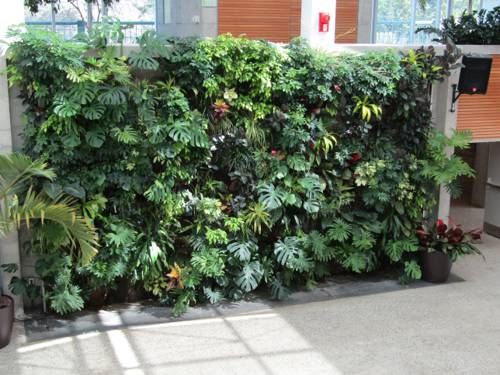
FAQ About Indoor Plant Biofiltration Systems

What is an indoor plant biofiltration system?
An indoor plant biofiltration system utilizes plants to purify indoor environments by removing pollutants and toxins from the air and water. These systems integrate plants into the mechanical and technical framework designed to enhance natural purification processes. Essentially, they mimic the natural filtration processes found in nature, providing improved air quality and water recycling within indoor spaces.

How do plants purify air in a biofiltration system?
Plants purify air through a process called phytoremediation. They absorb pollutants such as volatile organic compounds (VOCs), carbon dioxide, and benzene through their leaves and roots. Microorganisms in the soil further break down these compounds, while the plants convert carbon dioxide into oxygen through photosynthesis, enhancing air quality.

What types of plants are best for biofiltration systems?
Plants like spider plants, snake plants, pothos, and peace lilies are often recommended for biofiltration systems due to their ability to thrive indoors and efficiently remove a variety of pollutants from the air. These plants are known for their high transpiration rates and resilience, making them effective choices for improving indoor air quality.

Can indoor plant biofiltration systems filter water as well as air?
Yes, indoor plant biofiltration systems can be designed to filter water. Aquaponic systems, for example, integrate fish and plant life, allowing plants to absorb nutrients and pollutants from water. Such systems mimic the natural processes of wetlands, where water is cleaned through plant and microbial activity before being recirculated.

What are the benefits of using indoor plant biofiltration systems?
Indoor plant biofiltration systems offer several benefits, including improved air quality by removing toxins, enhancement of mood and productivity, reduction in allergens, and aesthetic improvements to space. Moreover, these systems can contribute to sustainable living practices by reducing the need for mechanical filtration systems.

How are indoor plant biofiltration systems different from traditional air purifiers?
Unlike traditional air purifiers that use mechanical filters to trap particles, indoor plant biofiltration systems leverage natural processes of plants and microbes to break down pollutants. While mechanical systems may require regular maintenance and replacement of filters, biofiltration systems are self-sustaining and biophilic, contributing to a healthier indoor environment.

What are some common pollutants that indoor plant biofiltration systems can remove?
Indoor plant biofiltration systems can remove a variety of pollutants, including volatile organic compounds (VOCs) like formaldehyde, benzene, and trichloroethylene, as well as carbon dioxide and particulate matter. They can also help in reducing levels of indoor allergens such as mold and dust.

Are indoor plant biofiltration systems energy-efficient?
Yes, indoor plant biofiltration systems are considered energy-efficient because they rely on natural processes rather than mechanical interventions. While some energy might be used to power auxiliary equipment like lighting or water pumps, overall energy consumption is typically lower compared to conventional air purification systems.

What factors should be considered when designing an indoor plant biofiltration system?
When designing an indoor plant biofiltration system, one must consider factors such as the types of pollutants present, the space available, light conditions, plant species' suitability, and system complexity. Additionally, integration with existing HVAC systems and the need for regular maintenance play critical roles in the system's efficacy.

Can indoor plant biofiltration systems be used in commercial buildings?
Yes, indoor plant biofiltration systems can be used in commercial buildings to improve air quality and contribute to environmental sustainability. These systems are ideal for offices, shopping centers, and universities, where they not only enhance air purity but also promote a healthier work environment and can be incorporated as part of the building’s aesthetic design.

What maintenance is required for indoor plant biofiltration systems?
Maintenance for indoor plant biofiltration systems typically includes regular watering, pruning, and monitoring of plant health. It may also involve checking the water levels in any integrated water filtration components and ensuring that lighting conditions are suitable for plant growth. Periodic system inspections may be necessary to ensure peak performance.

How effective are indoor plant biofiltration systems at improving air quality?
Research indicates that indoor plant biofiltration systems can effectively improve air quality by significantly reducing certain indoor air pollutants. Their effectiveness, however, depends on factors such as the volume of indoor space, types of plants used, pollutant levels, and system design. While not a complete replacement for mechanical systems in certain situations, they can be an important complement.

Can biofiltration systems be integrated into existing HVAC systems?
Yes, biofiltration systems can be integrated into existing HVAC systems, enhancing their efficiency and air purification capabilities. This integration allows for the distribution of purified air throughout the building and can reduce the need for mechanical filtering, leading to energy savings and improved indoor air quality.

What are the cost considerations for installing an indoor plant biofiltration system?
The cost of installing an indoor plant biofiltration system can vary widely based on its size, complexity, and design. Factors also include the type of plants used, additional components like lighting and water systems, and professional installation services. While initial costs may be higher, long-term savings through reduced energy use and health benefits can offset these expenses.

How do phytoremediation mechanisms work in biofiltration systems?
Phytoremediation mechanisms in biofiltration systems involve plants absorbing pollutants through their root and leaf systems. Once absorbed, these pollutants are either stored, degraded, or volatilized by the plant. Soil microorganisms also play a key role by transforming pollutants into less harmful substances, further enhancing the system's purification capabilities.

Can indoor plant biofiltration systems be used in residential homes?
Yes, indoor plant biofiltration systems are suitable for residential homes and can improve indoor air quality, enhance aesthetics, and provide a touch of nature indoors. They are particularly beneficial in urban settings where air quality may be compromised and can be customized to fit various home designs and sizes.

What is the role of microorganisms in biofiltration systems?
Microorganisms in biofiltration systems play a crucial role by breaking down pollutants absorbed by plant roots into less harmful substances. They contribute to the overall effectiveness of the system by facilitating the degradation of complex organic compounds, thereby enhancing plant-mediated purification processes.

How can light conditions affect indoor plant biofiltration systems?
Light conditions are crucial for the optimal performance of indoor plant biofiltration systems as they directly influence plant growth and photosynthesis. Adequate lighting ensures that plants remain healthy and capable of performing their air and water purification functions. Using grow lights can help maintain sufficient light levels, especially in areas with limited natural light.

What are some design tips for setting up an indoor plant biofiltration system?
When setting up an indoor plant biofiltration system, consider selecting plants known for high pollutant absorption, ensuring proper light levels, and integrating the system into your existing interior design. Also, providing adequate water supply and choosing a suitable substrate to support both plant and microbial life can enhance the system's effectiveness and aesthetic appeal.

Are there any limitations to indoor plant biofiltration systems?
While indoor plant biofiltration systems offer various benefits, they may have limitations, such as the need for specific environmental conditions and potential constraints in filtering larger volumes of air compared to mechanical systems. Their effectiveness can be influenced by plant species selection, system design, and maintenance requirements.
